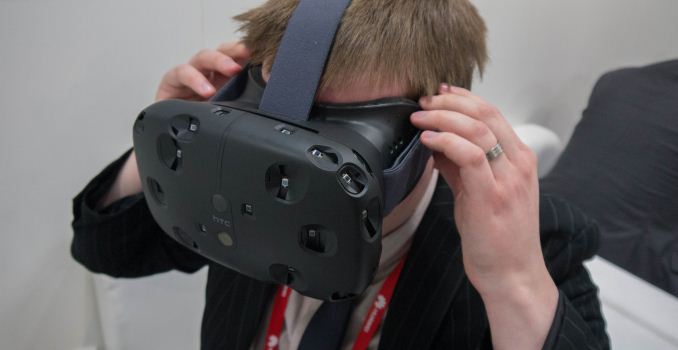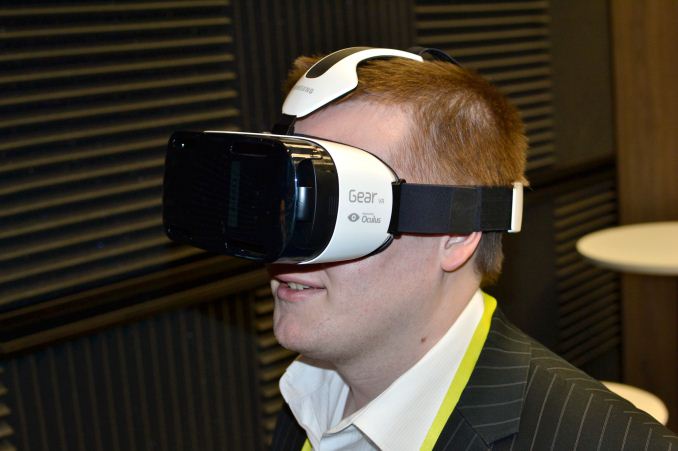IFA 2016: Examining the Malaise of Bargain Basement Virtual Reality
by Dr. Ian Cutress on September 9, 2016 9:00 AM EST
For the show this year, I left one day free just to roam freely around the show, looking for some insights or random bonus stories. One of the things that piqued my interest upon entering the International Tent was a number of VR headsets. It could be argued that the headsets that require a smartphone are a dime a dozen, so I scouted around for the VR headsets that were designed to come contained as all-in-one units and offer an untethered experience. A couple of the big names are touting untethered VR, so I asked around at a number of booths to look into the cheaper side of VR. For $100, you don’t get a lot.
For an all-in-one Virtual Reality headset, the core components include the screen resolution, screen size, screen quality, the SoC, the memory, the battery, the connectivity (wireless/LTE, USB etc.), the feel and the function of the headset are all key factors to get it right. In the myriad of six/seven headsets I was able to find in a morning at IDF, it was clear that almost all of these areas are gutted into the low-performance rung in order to meet very strict price points.
If we nostalgically look back to when Oculus was just starting, there were some clear defined goals that had to be achieved. For the most part they revolved around being to use the headset, eliminate nausea, and provide an immersive user experience. Millions of dollars and several prototypes later gave us the Rift, along with the Vive and other head-mounted displays (HMDs) that rely on a super powerful system behind it.
On the other side is Samsung Gear VR, leveraging an already owned premium smartphone with a reasonable element of a headset to house it – the smartphone is at a similar power budget to what you would expect to be the limit in front of the face. What these ‘bargain basement’ headsets try to do is try to provide all the hardware inside the headset, similar to the Gear VR, including SoC and battery and everything else, but for the same price as the Gear VR (minus smartphone). Of course, at the other end is Google Cardboard.
The true comparison points to these all-in-one VR systems could be the backpack VR units that house a laptop-like device, but these still require cables. The better comparison is to Intel’s Project Alloy, announced at IDF, or Qualcomm’s new VR820 platform, however both use internal and external cameras as part of a mixed VR/AR concept called mixed reality. We’ve seen other things like the SulonQ, which uses older AMD embedded parts, to provide the horsepower for an untethered VR experience as well. But all three of these are premium devices still in development. The goal of these cheaper headsets is to be super low cost, which also means there’s lots of competition to shave tenths of a cent off of the production costs.
As an additional caveat, the makers of these headsets I found on the show floor are the original design manufacturers, or ODMs. They are looking for bigger companies to order thousands of units and brand them under their own name, and subsequently deal with sales and distribution.












59 Comments
View All Comments
cocochanel - Saturday, September 10, 2016 - link
You could get a decent PC capable of VR for under a $1000. Say, a Zen + RX480 + 8Gigs RAM + SSD. Throw in an Oculus Rift for $600 and you're looking at around $1500. Where do you guys came up with the $3000 figure ? I suspect is the Nvidia camp who still insist that VR should start with a GTX 1080. C'mon.Death666Angel - Saturday, September 10, 2016 - link
Zen isn't out yet. Otherwise, yes, 3k is ridiculously overpriced for getting a VR ready setup.Icehawk - Saturday, September 10, 2016 - link
From testing I have seen online a 480 isn't close to enough firepower for VR at present the 1080 appears to be adequate and the Titan X is really the best option - and if VR takes off (it won't) even that hardware will likely be weak within a relatively short time frame. But I would agree $3k is being a bit generous, closer to 2k in reality with a 1080.Death666Angel - Saturday, September 10, 2016 - link
I haven't seen the same stuff as you then. All I read was in support of RX 480 being good enough for VR at this point in time. I don't argue that "more is better", but the benchmarks (Steam VR, people playing VR games @ 90fps) I have seen of the RX 480 and the minimum requirements of Oculus and HTC Vive point to the RX 480 being a good card for a VR ready PC. Any links would be appreciated. It's still tough to get dedicated VR tests from reliable websites. :)cptnjarhead - Thursday, September 15, 2016 - link
http://www.hardocp.com/article/2016/08/11/amd_nvid...From what i have read on hardocp VR reviews, the 480 has reprojection issues. Not sure if its DX11 related or not. But AMD needs to get it fixed cause right now the nvidia 1080 seems to be the only true "premium VR experience" . Not sure where all this liquid VR support is, but we are not seeing it.
Nagorak - Saturday, September 17, 2016 - link
The problem is UE4. It runs like crap on AMD hardware and it's not clear whether Epic is going to try to fix it, or if they're just going to laugh all the way to the bank where they cash nVidia's check.Half the games in VR are UE4. And, yes this hinders the experience on AMD immensely.
Nagorak - Saturday, September 17, 2016 - link
However there are still many games that do run alright on AMD. More horsepower is definitely better in VR, and that plus gimped UE4 means the best experience is sadly an Nvidia 970 and up. 290/390/480/X are still viable for many games but the experience suffers thanks largely to UE4.serendip - Saturday, September 10, 2016 - link
Cheap VR means no VR, at least for me. I've had enough of getting dizzy and vomiting after less than a minute of cheap Chinese VR "rides" that combine horrible low resolution displays and nausea-inducing movies with fast motion. All it takes is a few seconds of the eyes, inner ear and brain not syncing before lunch/dinner comes back up.I've also tried the Rift and Vive headsets. They're much more comfortable to wear and play on but the system cost and low overall resolution mean they're for hardcore gamers only for now.
Death666Angel - Saturday, September 10, 2016 - link
Using my hacked VRidge/Riftcat VR headset with 3D glasses (currently Fiit VR 2N) and my Nexus 6 works fairly well for 10 minutes (haven't bought the full version of the software yet and it only allows 10 minutes sessions in the free version). I can make myself sick by doing weird stuff in an Android roller coaster app though.Personally, I would need least 1080p 75Hz 5 - 5.5" with a gyroscope and a comfortable fit at under 200USD to consider this. The stuff I saw was either lacking too many features (resolution, tracking, refresh rate) or was too expensive (DK2 clone Deepoon E2 costs basically a little less than a used DK2 here, which is too much for me to consider a knock off).
DominionSeraph - Sunday, September 11, 2016 - link
"For the show this year"For what show?
You shouldn't write as though we've been following you around.